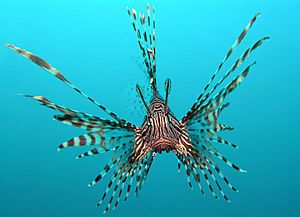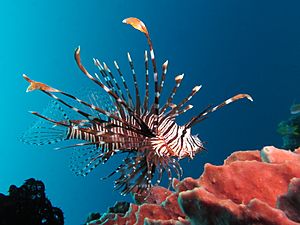Red lionfish facts for kids
Quick facts for kids Red lionfish |
|
|---|---|
 |
|
| Conservation status | |
| Scientific classification | |
| Genus: |
Pterois
|
| Species: |
volitans
|
The red lionfish (Pterois volitans) is a beautiful but venomous fish. It lives on coral reefs. This fish is naturally found in the Indo-Pacific region. However, it has become an invasive species in the Caribbean Sea and along the East Coast of the United States.
Red lionfish have striking white stripes mixed with red, maroon, or brown stripes. Adult lionfish can grow quite large, up to 47 cm (about 18.5 in) long. This makes them one of the biggest lionfish in the ocean. Young lionfish are usually smaller than 1 inch (2.5 cm). On average, a red lionfish lives for about 10 years.
This fish has long, venomous spines that stick out from its body. These spines look a bit like a lion's mane, which is how it got its name. The venom in these spines helps protect the fish from most predators. Lionfish can lay eggs every month. Their young can spread quickly to new areas. Because of this, their numbers have grown very fast in places where they are not native.
Contents
Where Red Lionfish Live
The red lionfish is originally from the Indo-Pacific region. This includes the western and central Pacific Ocean. It is also found off the coast of western Australia.
However, these fish were accidentally brought to the Western Atlantic Ocean. Now, they are an invasive species there. You can find them in the northern Gulf of Mexico too.
Life Cycle and Behavior
Reproduction
Red lionfish usually live alone. They only come together to find a mate. Often, one male will meet with several females. Both male and female lionfish look similar, except during mating season.
All types of Pterois lionfish show similar courtship behaviors. This includes swimming in circles, moving sideways, and following each other. Lionfish are mostly active at night. So, their mating behaviors usually happen from nightfall and continue through the night.
After courtship, the female releases two groups of eggs. The male fertilizes these eggs. The egg masses then float to the surface. The embryos inside the eggs make a sticky slime. This slime helps them attach to nearby rocks and corals before they hatch. A female can lay up to 30,000 eggs in one mating session! They tend to lay more eggs during warmer months.
Early Life and Spreading
We don't know much about the very young stage of lionfish. But we do know some things about their larvae. They have a large head, a long, pointed snout, and long, spiky head spines. They also have a large spine on their belly fins. Only their belly fins have color.
Lionfish larvae hatch about 36 hours after the eggs are fertilized. They are good swimmers. They can even eat tiny organisms called ciliates just four days after they are formed. The larval stage is the shortest part of a lionfish's life. It lasts for about one month.
Venomous Spines
The lionfish uses its venomous spines only for defense. If it feels threatened, it might turn upside down to point its spines at the attacker. A lionfish sting is usually not deadly to humans.
If a person is stung, they will feel extreme pain. They might also get headaches, throw up, or have trouble breathing. A common way to treat a sting is to soak the affected area in hot water. This can help break down the venom. It's always best to get immediate medical help, as some people react more strongly to the venom than others.
Red Lionfish as an Invasive Species
Two types of Pterois lionfish, P. volitans (red lionfish) and P. miles, have become big invasive species. They are found off the East Coast of the United States and in the Caribbean. About 93% of these invasive lionfish are the red lionfish.
The red lionfish probably first appeared off the coast of Florida in the 1980s. They most likely escaped from aquariums. Now, adult lionfish are found along the East Coast from Cape Hatteras, North Carolina, down to Florida. They are also in Bermuda, the Bahamas, and all over the Caribbean. This includes places like the Turks and Caicos, Haiti, Cuba, Puerto Rico, and Mexico.
Predators and Prey
In the areas where lionfish are invasive, very few animals eat them. Most large fish and sharks in the Atlantic and Caribbean haven't learned to see lionfish as food. This is probably because lionfish are new to these areas.
However, lionfish have been found in the stomachs of Nassau and tiger groupers in the Bahamas. But the Nassau grouper is in danger of disappearing, so it can't eat many lionfish. In their native home, two types of moray eels have been seen eating lionfish. A Bobbit worm, which hides and ambushes its prey, was also filmed eating a lionfish in Indonesia. Similar worms live in the Caribbean.
Lionfish themselves are very hungry eaters. They have taken over the role of other fish like snapper and grouper, which have been overfished. When hunting, they use their large fins to corner their prey. Then, they quickly swallow the prey whole. They mostly hunt from late afternoon until dawn.
Because lionfish eat so much and have a wide variety of food, their growing numbers are a big concern. They are changing and disrupting the food chains in the fragile ecosystems they have invaded. As these food chains are disturbed, the numbers of other fish populations go down. The overall variety of life on coral reefs also decreases.
See also
 In Spanish: Pez león colorado para niños
In Spanish: Pez león colorado para niños



